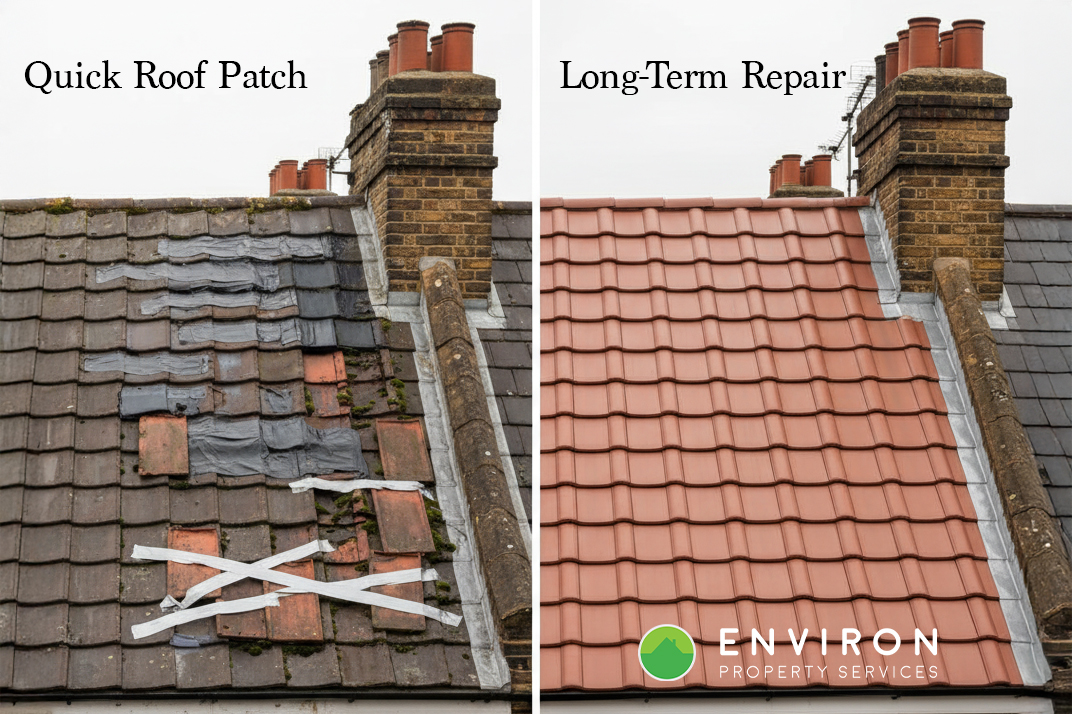- About Us
- Services
- Blog
- Contact
Need a quote?
When roof damage occurs, whether it’s a missing tile, a leak, or a tear in a flat roof membrane, homeowners are often faced with a choice: patch the problem quickly or invest in a proper repair.
At first glance, a quick patch is the easiest and cheapest solution. However, it’s important to understand the difference between temporary fixes and long-term repairs, and the effect each can have on your property over time.




A roof patch is a short-term solution designed to stop immediate problems such as leaks or drafts. It usually involves applying sealant, replacing a single tile, or covering a damaged area temporarily.
While this can stop water infiltration at the moment, it doesn’t always address the root cause. If the underlying roofing structure or surrounding tiles are compromised, the problem is likely to return, often worse than before.
Patching can be appropriate when damage is minimal and localised. For example, if a single tile has slipped during a storm, replacing it is usually sufficient. Similarly, if a roof is newer and the damage is isolated, a patch can be effective without compromising long-term performance.
Long-term repairs go beyond the surface. They get to the source of the issue, whether that’s weakened underlayment, deteriorating flashing, ageing tiles, or moisture infiltration. A more comprehensive repair ensures structural integrity and prevents further damage. While it may cost more upfront, it can save significant money and stress over time by preventing recurring leaks, mould growth, and internal damage.
Choosing to repeatedly patch rather than properly repair can lead to bigger problems. Leaks can spread, structural timber can rot, and insulation can become waterlogged. At that point, homeowners are no longer facing a repair; they’re facing a full roof replacement.
The best course of action depends on your roof’s age, condition, and the extent of the roof damage. A professional roofing inspection can provide clarity and help you make a cost-effective choice that protects your home.
In the end, a quick patch might solve the problem today, but a long-term repair protects your roof, and your peace of mind for years to come.
It depends on the construction, but the minimum weight a flat roof must be capable of bearing is 300lbs. This refers to a concentrated weight where a load is positioned on just one area of the roof. So, for example, a commercial flat roof can approximately support a 300lb HVAC unit in a 2.5×2.5ft single space.
Over time, damaged or unmaintained roofs can become entry points for pests such as birds, squirrels, or insects. These intruders can cause further damage, contaminate insulation, and even create fire hazards by nesting near electrical components.
If your roof is over 20 years old, shows visible signs of damage, or has caused recurring issues indoors, it’s time to consult a professional roofer. They can assess the roof’s condition, identify hidden dangers, and advise whether repairs or full replacement are necessary.
Ignoring the risks of an ageing roof can lead to expensive repairs and even compromise your safety.
Regular roof inspections, timely maintenance, and professional assessments ensure your home remains secure, energy-efficient, and free from the hidden hazards that old roofs often conceal.


